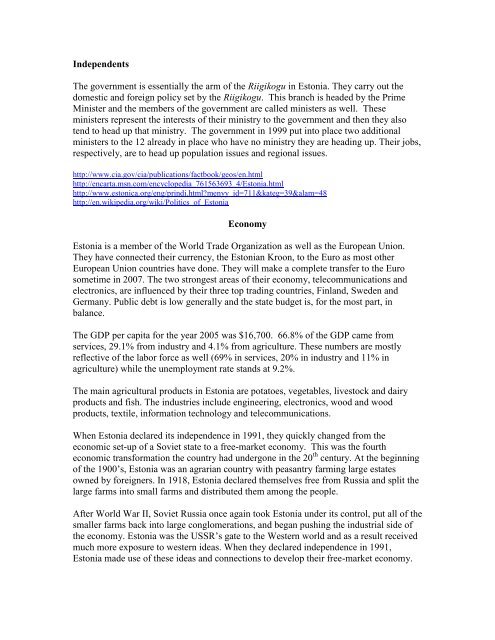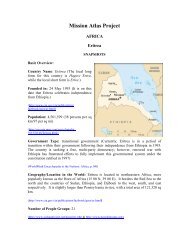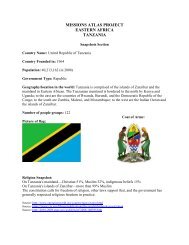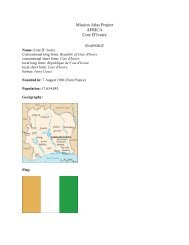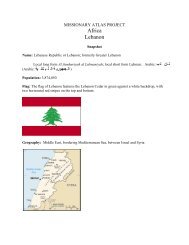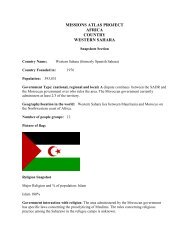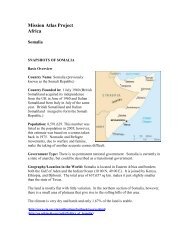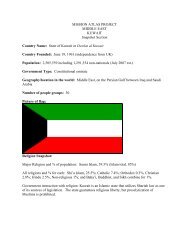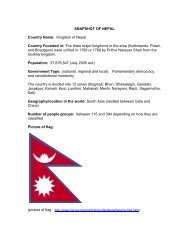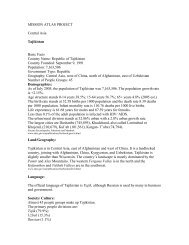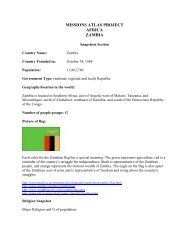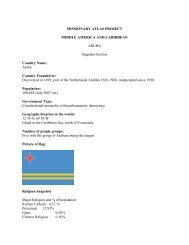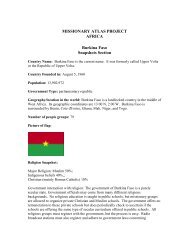Estonia Profile.pdf - WorldMap
Estonia Profile.pdf - WorldMap
Estonia Profile.pdf - WorldMap
You also want an ePaper? Increase the reach of your titles
YUMPU automatically turns print PDFs into web optimized ePapers that Google loves.
IndependentsThe government is essentially the arm of the Riigikogu in <strong>Estonia</strong>. They carry out thedomestic and foreign policy set by the Riigikogu. This branch is headed by the PrimeMinister and the members of the government are called ministers as well. Theseministers represent the interests of their ministry to the government and then they alsotend to head up that ministry. The government in 1999 put into place two additionalministers to the 12 already in place who have no ministry they are heading up. Their jobs,respectively, are to head up population issues and regional issues.http://www.cia.gov/cia/publications/factbook/geos/en.htmlhttp://encarta.msn.com/encyclopedia_761563693_4/<strong>Estonia</strong>.htmlhttp://www.estonica.org/eng/prindi.html?menyy_id=711&kateg=39&alam=48http://en.wikipedia.org/wiki/Politics_of_<strong>Estonia</strong>Economy<strong>Estonia</strong> is a member of the World Trade Organization as well as the European Union.They have connected their currency, the <strong>Estonia</strong>n Kroon, to the Euro as most otherEuropean Union countries have done. They will make a complete transfer to the Eurosometime in 2007. The two strongest areas of their economy, telecommunications andelectronics, are influenced by their three top trading countries, Finland, Sweden andGermany. Public debt is low generally and the state budget is, for the most part, inbalance.The GDP per capita for the year 2005 was $16,700. 66.8% of the GDP came fromservices, 29.1% from industry and 4.1% from agriculture. These numbers are mostlyreflective of the labor force as well (69% in services, 20% in industry and 11% inagriculture) while the unemployment rate stands at 9.2%.The main agricultural products in <strong>Estonia</strong> are potatoes, vegetables, livestock and dairyproducts and fish. The industries include engineering, electronics, wood and woodproducts, textile, information technology and telecommunications.When <strong>Estonia</strong> declared its independence in 1991, they quickly changed from theeconomic set-up of a Soviet state to a free-market economy. This was the fourtheconomic transformation the country had undergone in the 20 th century. At the beginningof the 1900’s, <strong>Estonia</strong> was an agrarian country with peasantry farming large estatesowned by foreigners. In 1918, <strong>Estonia</strong> declared themselves free from Russia and split thelarge farms into small farms and distributed them among the people.After World War II, Soviet Russia once again took <strong>Estonia</strong> under its control, put all of thesmaller farms back into large conglomerations, and began pushing the industrial side ofthe economy. <strong>Estonia</strong> was the USSR’s gate to the Western world and as a result receivedmuch more exposure to western ideas. When they declared independence in 1991,<strong>Estonia</strong> made use of these ideas and connections to develop their free-market economy.


